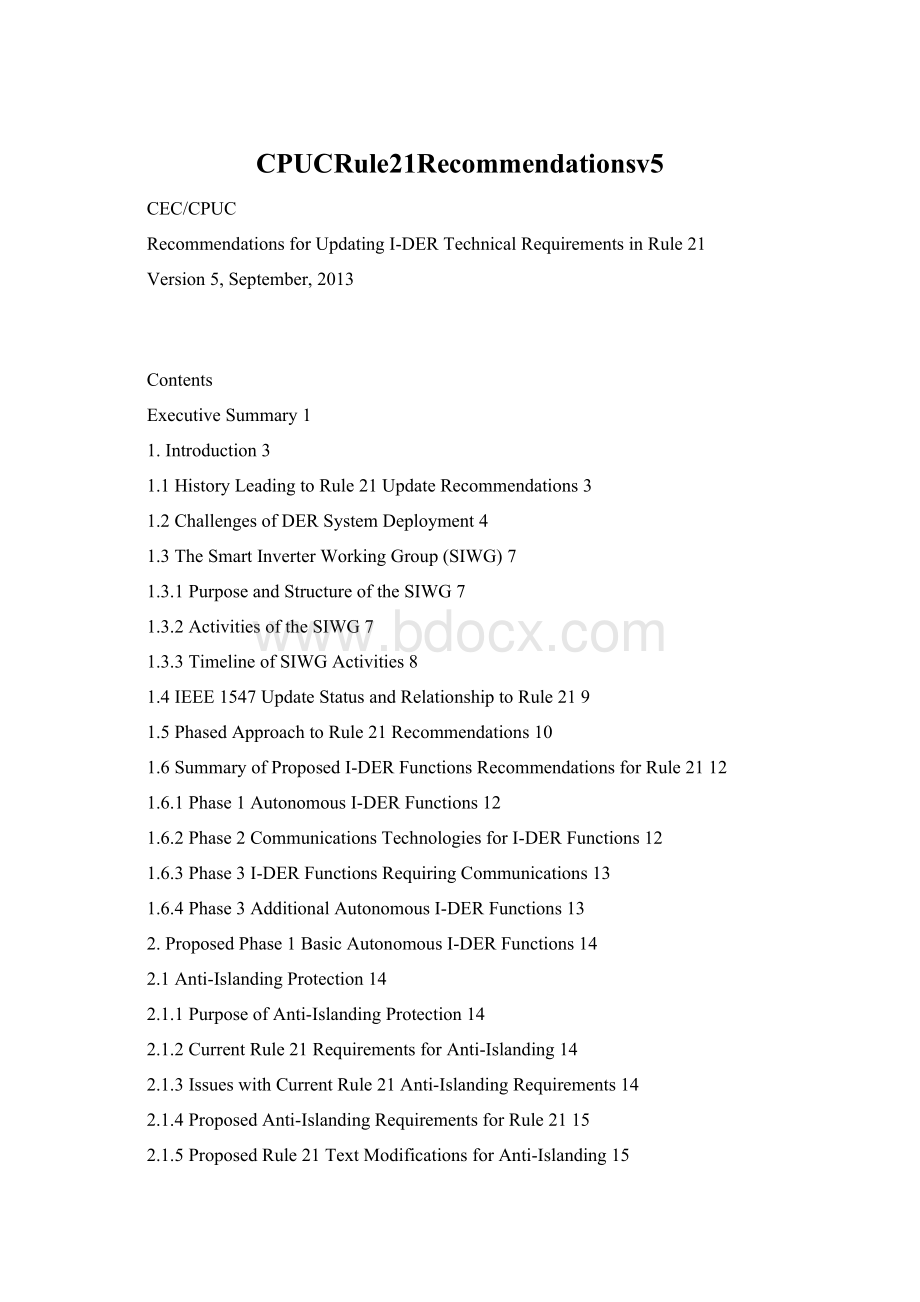CPUCRule21Recommendationsv5.docx
《CPUCRule21Recommendationsv5.docx》由会员分享,可在线阅读,更多相关《CPUCRule21Recommendationsv5.docx(84页珍藏版)》请在冰豆网上搜索。

CPUCRule21Recommendationsv5
CEC/CPUC
RecommendationsforUpdatingI-DERTechnicalRequirementsinRule21
Version5,September,2013
Contents
ExecutiveSummary1
1.Introduction3
1.1HistoryLeadingtoRule21UpdateRecommendations3
1.2ChallengesofDERSystemDeployment4
1.3TheSmartInverterWorkingGroup(SIWG)7
1.3.1PurposeandStructureoftheSIWG7
1.3.2ActivitiesoftheSIWG7
1.3.3TimelineofSIWGActivities8
1.4IEEE1547UpdateStatusandRelationshiptoRule219
1.5PhasedApproachtoRule21Recommendations10
1.6SummaryofProposedI-DERFunctionsRecommendationsforRule2112
1.6.1Phase1AutonomousI-DERFunctions12
1.6.2Phase2CommunicationsTechnologiesforI-DERFunctions12
1.6.3Phase3I-DERFunctionsRequiringCommunications13
1.6.4Phase3AdditionalAutonomousI-DERFunctions13
2.ProposedPhase1BasicAutonomousI-DERFunctions14
2.1Anti-IslandingProtection14
2.1.1PurposeofAnti-IslandingProtection14
2.1.2CurrentRule21RequirementsforAnti-Islanding14
2.1.3IssueswithCurrentRule21Anti-IslandingRequirements14
2.1.4ProposedAnti-IslandingRequirementsforRule2115
2.1.5ProposedRule21TextModificationsforAnti-Islanding15
2.1.6BenefitsoftheProposedNewAnti-IslandingRequirements15
2.2Low/HighVoltageRide-Through(L/HVRT)15
2.2.1PurposeofL/HVRT15
2.2.2CurrentRule21RequirementsforL/HVRT16
2.2.3IssueswithCurrentRule21L/HVRT16
2.2.4L/HVRTFunctionConcepts16
2.2.5ProposedRule21DefaultVoltageRide-ThroughRequirements17
2.2.6ProposedRule21TextModificationforL/HVRT18
2.2.7BenefitsoftheProposedL/HVRTRequirements18
2.3Low/HighFrequencyRide-Through(L/HFRT)19
2.3.1PurposeofL/HFRT19
2.3.2CurrentRule21RequirementsforL/HFRT19
2.3.3IssueswithCurrentRule21L/HFRT19
2.3.4L/HFRTFunctionConcepts20
2.3.5ProposedRule21DefaultFrequencyRide-ThroughRequirements20
2.3.6ProposedRule21TextModificationforL/HFRT23
2.3.7BenefitsoftheProposedL/HFRTRequirements23
2.4DynamicVolt/VarOperations23
2.4.1PurposeofDynamicVolt/VarOperations23
2.4.2CurrentRule21RequirementsforDynamicVolt/VarOperations23
2.4.3IssueswithCurrentRule21DynamicVolt/VarOperations23
2.4.4DynamicVolt/VarOperationsConcepts24
2.4.5ProposedRule21DefaultDynamicVolt/VarOperationRequirements25
2.4.6ProposedRule21TextModificationforDynamicVolt/VarOperations27
2.4.7BenefitsoftheProposedDynamicVolt/VarOperationsRequirements27
2.5RampRates27
2.5.1PurposeofRampRates27
2.5.2CurrentRule21RequirementsforRampRates28
2.5.3IssueswithCurrentRule21onRampRates28
2.5.4ProposedRampRateRequirements28
2.5.5ProposedRule21TextModificationforRampRates29
2.5.6BenefitsoftheProposedRampRateRequirements29
2.6FixedPowerFactor29
2.6.1PurposeofFixedPowerFactor(PF)29
2.6.2CurrentRule21RequirementsforFixedPowerFactor29
2.6.3IssueswiththeCurrentRule21RequirementforFixedPowerFactor29
2.6.4FixedPowerFactorConcepts29
2.6.5ProposedFixedPowerFactorRequirements29
2.6.6ProposedRule21TextModification30
2.6.7BenefitsoftheProposedFixedPowerFactorCapability30
2.7Reconnectby“Soft-Start”Methods30
2.7.1PurposeofReconnectionby“Soft-Start”Methods30
2.7.2CurrentRule21RequirementsonReconnection30
2.7.3IssueswithCurrentRule21onReconnection30
2.7.4“Soft-Start”ReconnectionConcepts30
2.7.5ProposedRule21ReconnectionRequirements31
2.7.6ProposedRule21TextModificationsfor“Soft-Start”Reconnection31
2.7.7BenefitsoftheProposed“Soft-Start”Reconnection31
2.8Phase1I-DERSystemParametersandMonitoredPoints31
2.8.1Phase1I-DERParameters31
2.8.2NameplateInformation35
2.8.3I-DERSystemMonitoredPoints36
3.ProposedPhase2CommunicationsTechnologiesforI-DERFunctions38
3.1PurposeofCommunicationTechnologiesforI-DERfunctions38
3.2CurrentRule21RequirementsforCommunications38
3.3IssueswiththeCurrentRule21LackofRequirementsforCommunications38
3.4CommunicationConceptsandIssues39
3.4.1HierarchicalConfigurationofI-DERSystems39
3.4.2CommunicationAlternatives42
3.5ProposedCommunicationRequirementsforRule2143
3.6ProposedRule21TextModifications44
3.7BenefitsofCommunicationswithI-DERSystems44
4.ProposedPhase3AdditionalI-DERFunctions45
4.1PurposeoftheAdditionalI-DERFunctions45
4.2CurrentRule21RequirementsforAdditionalI-DERFunctions45
4.3IssueswiththeCurrentRule21LackofAdditionalI-DERFunctions45
4.4ProposedAdditionalI-DERFunctionsforRule2146
4.5ProposedRule21TextModifications46
4.6BenefitsoftheAdditionalI-DERFunctions46
5.ProposedTestPlan47
5.1IntroductiontotheTestPlanforSmartI-DERSystems47
5.1.1ScopeandPurpose47
5.1.2TypesofTests47
5.1.3SourcesofTestingRequirements48
5.2ImplementationProcedures48
5.2.1ULCertificationforPilotandforCommercialI-DERSystems48
5.2.2PermissiveImplementationSchedules49
5.2.3StaggeredTestgroups49
5.3SchedulesforPermissiveImplementationsofStaggeredTestingofSmartI-DERFunctions50
5.3.1GanttChartofTestPlanImplementationSchedule52
5.3.2CPUC-RelatedTasks:
Review,Comment,andUpdateCPUCOn-RecordDocuments53
5.3.3SmartInverterWorkingGroup(SIWG)Tasks54
5.3.4TestgroupA–Phase1AutonomousFunctionsforLargerI-DERSystems55
5.3.5TestgroupB–Phase1AutonomousFunctionsforSmallerI-DERSystems55
5.3.6TestgroupC–Phase2CommunicationsCapabilitiesforI-DERSystems56
5.3.7TestgroupD–Phase3AutonomousI-DERFunctions57
6.ProposedMilestones59
7.Conclusions60
A.AnnexA:
OverviewofMandatory,Recommended,OptionalI-DERFunctions61
A.1Phase1:
KeyAutonomousI-DERFunctions61
A.2Phase2:
CommunicationsTechnologiesforI-DERFunctions64
A.3Phase3:
I-DERFunctionsRequiringCommunications65
A.4Phase3:
AdditionalAutonomousI-DERFunctions67
A.5OptionalI-DERFunctions70
B.AnnexB:
DefinitionsofTermsandAcronyms74
Figures
Figure1:
Previousactivitiesandexpectedtimelineforfutureactivities9
Figure2:
PhasedapproachtointegratingI-DERsystemswithutilityoperations11
Figure3–Mustdisconnectandmustremainconnectedzones17
Figure4:
Graphofdefaultvoltageride-throughsettings18
Figure5:
WECCL/HFRTrangesincomparisontoproposedIEEE1547aranges21
Figure6:
WECCL/HFRTrangesshowingpossiblemust-stay-connectedband21
Figure7:
ProposedfrequencyparametersinIEEE1547a22
Figure8:
Examplesettingsofvolt/varmodeusingavailablevars24
Figure9:
Exampleofvolt/varcurvewithdeadbandsshownasbandsonthecurve24
Figure10:
Exampleofvolt/varcurvewithhysteresis,witharrowsindicatingdirectionofvoltagechanges25
Figure11:
P-Qcapabilitycurve(P:
realpower;Q:
reactivepower;S:
apparentpower)25
Figure12:
First4LevelsoftheHierarchicalI-DERSystemArchitectureShowingCommunicationProtocols41
Figure13:
Communicationgatewayfortranslatingprotocols43
Figure14:
StaggeredTestgroups50
Tables
Table1:
DefaultRule21voltageride-throughvoltage-timevalues18
Table2:
WECCOffNominalFrequencyLoadSheddingLimits20
Table3:
Defaultinterconnectionsystemresponsetoabnormalfrequencies(IEEE1547a)22
Table4:
Examplesofvolt/varsettings27
Table5:
Phase1I-DERParameters32
Table6:
NameplateandStaticSettings35
Table7:
I-DERSystemMonitoredPoints36
Table8:
InitialTasks:
Review,Comment,andUpdateDocuments53
Table9:
SmartInverterWorkingGroupTasks54
Table10:
TestgroupA–Phase1AutonomousFunctionsforLargerI-DERSystems55
Table11:
TestgroupB–Phase1AutonomousFunctionsforSmallerI-DERSystems56
Table12:
TestgroupC–Phase2CommunicationsCapabilitiesforI-DERSystems57
Table13:
TestgroupD–Phase3AutonomousI-DERFunctions58
Table14:
Milestones59
Table15:
Phase1BasicAutonomousI-DERfunctions62
Table16:
Standards-basedcommunicationstechnologiesrequirements64
Table17:
I-DERfunctionsrequiringcommunications66
Table18:
Phase3AdditionalAutonomousI-DERfunctions67
Table19:
OptionalI-DERFunctions70
ExecutiveSummary
CaliforniaGovernorBrownhascalledfortheimplementationof12,000MWof“localizedelectricitygeneration”,whichcanhelptheStatereachitsgoaltoacquire33percentofitsenergyfromeligiblerenewableenergyresourcesby2020.SubstantialamountsofgenerationandstoragecapacityoftheseDistributedEnergyResource(DER)systemswillprovidesignificantenvironmentalandfinancialbenefits,buttheyalsoposesignificanttechnicalchallenges.Forinstance,DERsystemsarelocatedwithindistributiongridswhichweredesignedonlyforone-wayflowsofpowerfromsubstationsthroughthedistributiongridtocustomerloads.DERsystemspoweredfromrenewablesourcesgenerallyhavevaryingenergyoutput.
Overthelastfewyears,manylongdiscussionswithDERexpertshavetakenplace;detailedanalysisandmodelingofpowersystemimpactshavebeenundertakenparticularlyofhighpenetrationsofDERsystems;andDERsystemshavebeentestedtobetterunderstandtheircapabilitiesandtheirresponsestodifferentsituations.TheresultsoftheseeffortshavebeenreviewedbyEuropeanandUSutilities,bytheIECgroupsdevelopingstandardsforthefunctions,bytheIEEEgroupsworkingonupdatingtheIEEE1547seriesofinterconnectionstandards,andbytheSIWGmembers.AlthoughthereisgeneralagreementontheneedforincorporatingsmartDERfunctionsintogridoperationsandbroadagreementonthemostimportantfunctions,itisclearthatthedetailedrequirementsforsomeoftheDER